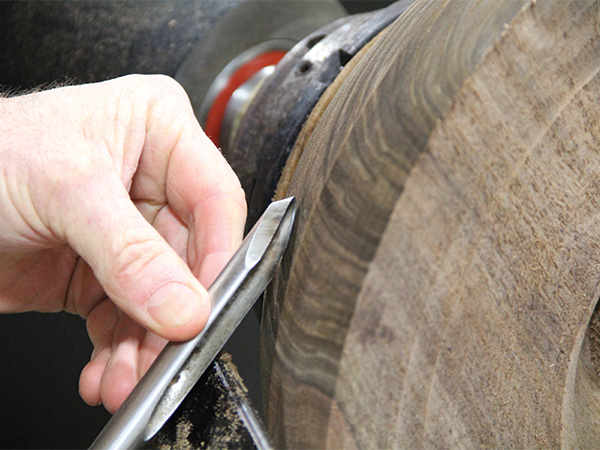
This article, “Closer Look at Sheer Scraping,” by Mike Mahoney, is from the pages of American Woodturner and is brought to you by the America Association of Woodturners (AAW) in partnership with Woodworker’s Journal.
Conventional woodturning wisdom tells us the preferred way to cut wood on the lathe is with a bevel-rubbing cut. With that tool presentation, the bevel supports the edge of the tool, keeps it sharper longer, and provides a guide to achieve your desired line or curve. In my business as a professional bowl turner, I have found that another valuable technique is shear-scraping, which I do to further refine and remove slight imperfections such as tear out from some (but not all) turned surfaces. When done correctly, shear-scraping can dramatically reduce the amount of sanding required. It allows you to “rub out” high spots, blemishes, and tool marks easily.
When to Shear-scrape
Shear-scraping is typically applied to the exterior of sidegrain turnings (with the grain running perpendicular to the lathe bed, also known as faceplate work). It works exceptionally well on bowl exteriors prior to hollowing and on platters. It is also handy for anyone making hollow forms with burl or sidegrain wood. Often, hollow form shapes have sloping curves, and when your workpiece is still mounted between centers, the lathe’s headstock and tailstock can get in the way of making bevel-rubbing cuts. Shear-scraping is sometimes the only way to connect the upper and lower curves on this type of form.
Another benefit of shear-scraping is that it can be applied in any cutting direction, left or right, regardless of grain direction.
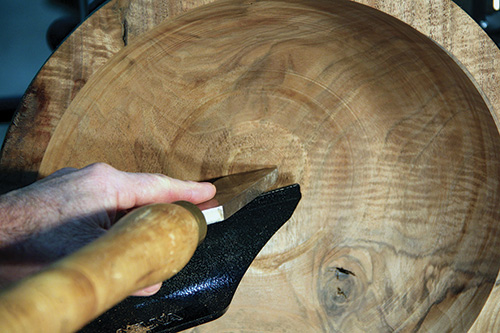
I don’t recommend shear-scraping endgrain, as doing so tears the wood fibers badly. Bevel-rubbing cuts work better for spindle work (with the grain running parallel to the lathe bed). I also do not recommend shear-scraping the inside of a bowl, though, based on what I have seen on YouTube, many people do. The reason it is safe to shear-scrape the outside of a bowl is that you would do it prior to hollowing the bowl, so the interior wood adds stability. After you have hollowed a bowl, it is risky to shear-scrape its interior walls. Inside a bowl, I recommend flat-scraping the bottom third only with a round-nose scraper, not shear-scraping with a spear-pointed tool.
Shear-scraping Two Ways
When you shear-scrape a turned surface, you hold a sharp edge to the wood without bevel contact at an angle steeper than horizontal. Shear-scraping should only be used for light wood removal, as it is a finesse cut ideally used for refinement prior to (and sometimes instead of) final sanding.
I use one of two tools for this cut: a gouge with a very sharp cutting edge or a scraper with a burr edge. Using a gouge tends to leave a better surface, but you might find the scraper offers better results in denser burl-structured wood. The gouge also requires a bit more skill. The edge of a shear-scraping tool, whether a gouge or scraper, dulls quickly, so expect to sharpen often.
Gouge
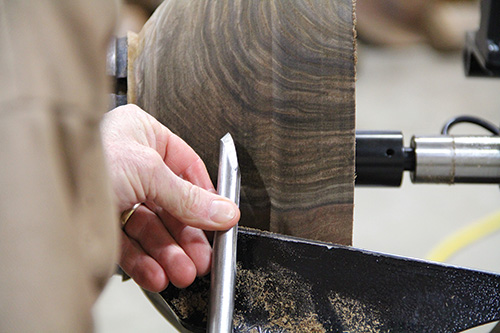
Shear-scraping with one wing of a gouge makes use of a very sharp tool edge. I have developed a grind for my 1/2″, or 13mm, bowl gouge for shear-scraping that gives me the ability to get a steeper approach. This grind is essentially a modified fingernail gouge with a long, convex, cutting edge.
The wood shavings that result from shear-scraping with a gouge are fine and ribbon-like.
Scraper
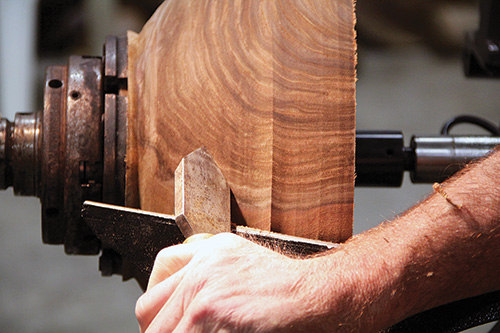
Unlike the gouge approach, shear-scraping with a scraper makes use of a burr edge. I like teaching this method because it provides results similar to those of a gouge, but with the benefit of more control, which is important for beginners.
I use a heavy spear-point scraper that was formerly a round-nose scraper. I ground a new shape on it according to my preference. Round-nose scrapers will work for shear-scraping, too, as long as they are made from metal stock at least 1/4″ (6mm) thick. This thickness will help reduce vibration, which is important for a clean shear-scrape. One extra benefit of a spear-point scraper is that its sharp point can also be used as a detail tool.
I use this tool with a burr developed right from the grinder since it is only used sparingly. If I were focused on using the tool for an extended time, I would create a burr on it using a burnisher (just as a furniture maker does with a cabinet scraper). When used in shear-scraping mode, the burr on a scraper has an effect similar to that of an abrasive: the wood shavings removed are finer in structure.
How It’s Done
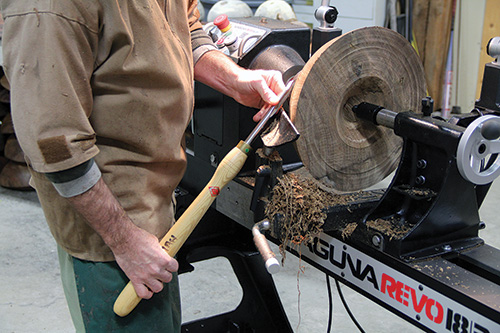
Let’s look at how I use shear-scraping in my bowl-making process. Using a 1/2″ bowl gouge, I turn the exterior of a bowl with a series of bevel-rubbing cuts, both with and against the grain. Once I have established the shape I want, I begin to shear-scrape the exterior surface. There are two factors that are key to success in this process: use a freshly sharpened tool and present the cutting edge of the tool at a steep angle to the wood. To get this steep angle, imagine putting the tool handle in your right pocket (if you are righthanded); this will create the desired tool presentation.
Keep a firm grip on the tool and hard pressure on the toolrest to minimize tool vibration and to keep the tool from bouncing away from the wood. If you find the tool is bouncing, apply more pressure on the toolrest and lighter strokes on the wood. It is not necessary to shear-scrape with the grain direction, since you are gently scraping “over” the grain and not cutting into it. You can go up or down on the shape, depending on what feels best for you. I like to get at least a 45-degree presentation angle of the cutting edge on the wood and sometimes even steeper.
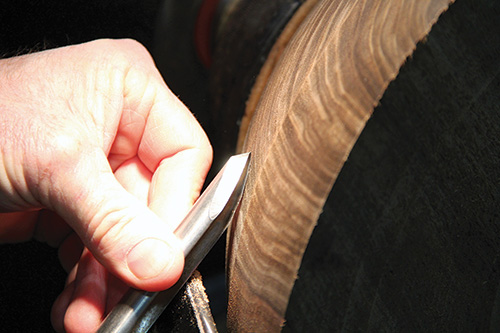
When shear-scraping with a gouge, present the tool with the flute closed (almost facing the wood), but be sure to use only the lower cutting wing of the gouge. Touching the opposite wing, or both wings, could cause a catch.
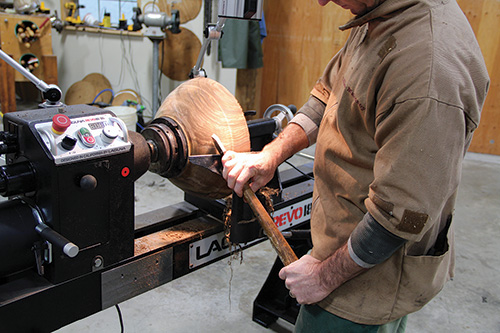
When shear-scraping with a scraper, the tool presentation is similar to shear-scraping with a gouge: drop the tool handle low and present the burr edge at a steep angle to the wood. To achieve this steep angle, it is necessary to turn the tool up on edge, rather than resting its width on the toolrest, as you would in the traditional scraping mode.
Final Thoughts
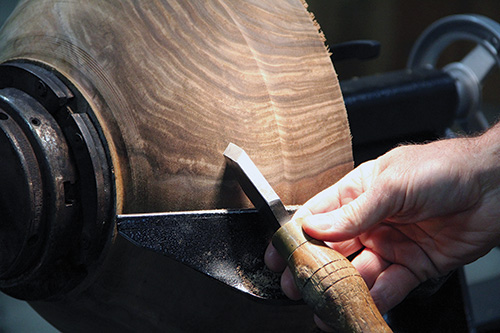
Still having trouble getting a smooth cut after using these techniques? Sometimes tearout can be a bear to eliminate. Try using a lubricant for that last cut. I recommend using your intended finish as a lubricant. For instance, if you are going to finish your bowl with mineral oil, try mineral oil as the lubricant. And remember to keep the edge of the tool at a steep angle to the grain. Drop the handle and close the flute of the gouge into the wood — but not so far as to touch the opposite wing, as that would cause a catch.
Mike Mahoney is a production woodturner specializing in salad bowls, utility items, and burial urns. He lives in rural Northern California on a farm with his wife, Jenni. For more, visit bowlmakerinc.com.





